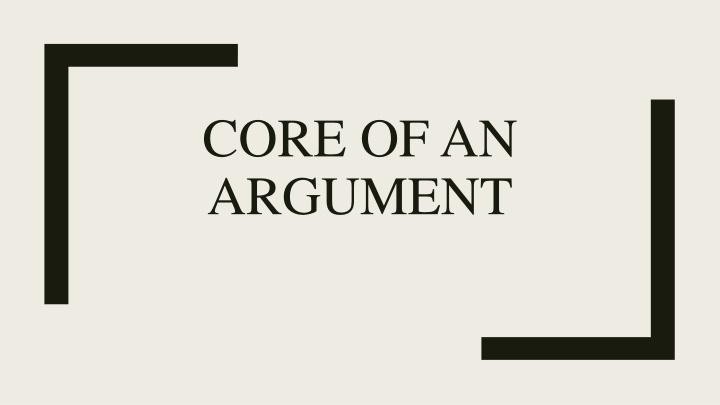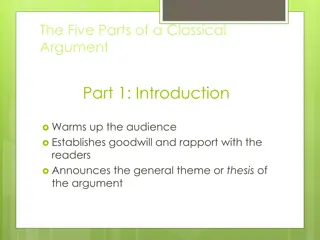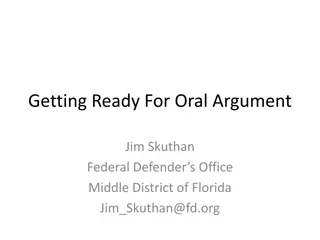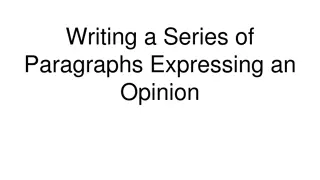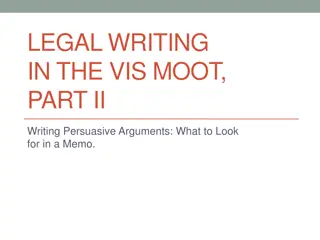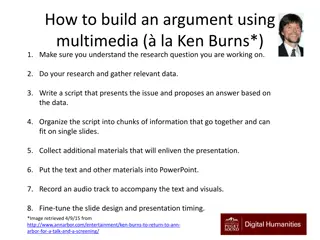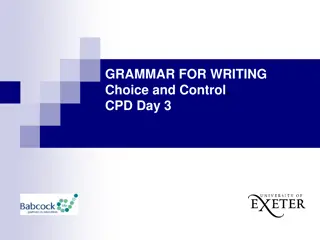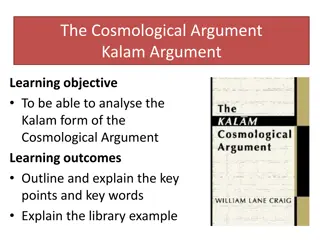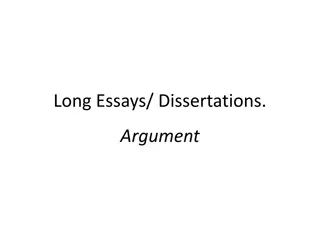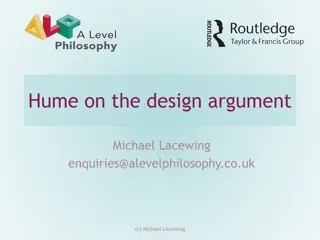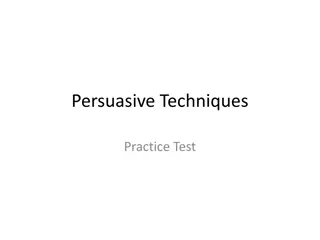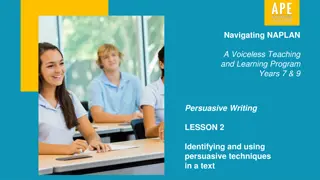Crafting a Persuasive Classical Argument
Crafting a persuasive classical argument involves following a structured approach that includes grabbing the reader's attention in the introduction, presenting the writer's position with reasons and evidence, summarizing and critiquing alternative views, and concluding with a strong final impression. While the classical structure is effective, sometimes deviating from it can enhance persuasiveness.
Download Presentation

Please find below an Image/Link to download the presentation.
The content on the website is provided AS IS for your information and personal use only. It may not be sold, licensed, or shared on other websites without obtaining consent from the author.If you encounter any issues during the download, it is possible that the publisher has removed the file from their server.
You are allowed to download the files provided on this website for personal or commercial use, subject to the condition that they are used lawfully. All files are the property of their respective owners.
The content on the website is provided AS IS for your information and personal use only. It may not be sold, licensed, or shared on other websites without obtaining consent from the author.
E N D
Presentation Transcript
CORE OF AN ARGUMENT
Introduction Grabbing the Readers Attention: telling a current event using an illustrative story showing memorable scene giving startling statistic Focusing the issue stating it directly as a question briefly summarizing opposing views providing needed background and context. presenting their claim (thesis statement) forecasting the argument s structure (the main parts)
Presentation of the Writers Position The longest part of a classical argument. Reasons and evidence that support their claims are presented The reason and evidence: related to the audience s values, beliefs, and assumptions each developed in its own paragraph or sequence of paragraphs When a paragraph introduces a new reason, it is stated directly and then supported with evidence or a chain of ideas Appropriate transitions are used throughout
Summary and Critique of Alternative Views There are several options to write opposing views: If there are several opposing arguments, All of them may be summarized together and composed into a single response or Each argument may be summarized and responded in turn. Opposing views may be refuted or their strengths may be accepted by shifting to a different field of values.
Conclusion Argument is summed up Claims are restated Some kind of action can be called for A sense of closure is created and a strong final impression is left.
The main sections of a classical argument Two major sections presenting the writer s own position summarizing and responding to alternative views In general writer s own position comes first, but it is possible to reverse that order.
Persuasiveness of classical argument An argument with a classical structure may not always be the most persuasive strategy. you may be more effective by delaying your thesis, ignoring alternative views altogether, or showing great sympathy for opposing views However, the classical structure is a useful planning tool. Intro presents the the whole of your argument in miniature. Summary and opposing views alerts you to the limits of your position and to the need for further reasons and evidence.
The Rhetorical Triangle Persuasive speeches are analyzed considering three appeals: logos (MESSAGE) ethos (WRITER/SPEAKER) pathos (AUDIENCE)
LOGOS (Greek for word ) attention is on the quality of the message internal consistency, the clarity of the argument, and the logic of its reasons Its impact on the audience is called as LOGICAL APPEAL
ETHOS (Greek for character ) Attention is on the writer s / speaker s character: Credibility of the writer Fairness while considering alternative views Tone and style Professional appearance (including grammar, citations, etc) Honesty Its impact on the audience is ETHICAL APPEAL (APPEAL FROM CREDIBILITY)
PATHOS (Greek for suffering or experience ) Attention is on the values and beliefs of attended audience Associated with emotional appeal More specifically attracts an audience s imaginative sympathies (their capacities to feel and see what the writer feels and sees) In sum, whereas appeals to logos and ethos can further an audience s intellectual assent to our claim, appeals to pathos engage the imagination and feelings, moving the audience to a deeper appreciation of the argument s signigicance
What are we doing then? Making a pathetic appeal by abstracting logical discourse into a tangible and immediate story Appeals to logos and ethos can help an audience s intellectual agreement with our claim Appeals to pathos can move the audience to a deeper appreciation of the argument s significance
A related Word: KAIROS (Greek word for right time, season, or opportunity ) How to make persuasive argument: its timing must be effectively chosen its tone and structure must be in right proportion or measure. You may ask such questions before sending an argumentative e-mail: Is this the right moment to send this message? Is my audience ready to hear what I m saying? Would my argument be more effective if I waited for a couple of days? If I send this message now, should I change its tone and content? This attentiveness to the unfolding of time is what is meant by kairos.
Issue vs Information Questions Issue questions: can be answered reasonably in two or more differing ways Information questions: can be answered in one way E.g. How does adult literacy rate in Turkey compare with the rate in Germany? If the rates are different, why?
Issue vs Information Questions Issue questions: can be answered reasonable in two or more differing ways Information questions: can be answered in one way E.g. How does adult literacy rate in Turkey compare with the rate in Germany? If the rates are different, why? Information question
Issue vs Information Questions Issue questions: can be answered reasonable in two or more differing ways Information questions: can be answered in one way E.g. How does adult literacy rate in Turkey compare with the rate in Germany? If the rates are different, why? Issue question
Sometimes the same question can be an information question in one context and an issue question in another E.gs How does a diesel engine work? info question anyone who knows about diesel engines would agree on how it Works (maybe asked by new learners) Why is a diesel engine more fuel efficient than a gasoline engine? info question anyone who knows about diesel engines would agree on how it Works (maybe asked by new learners)
What is the most cost-effective way to produce diesel fuel from crude oil? Info if experts agree and new learners are addressed Issue if experts are addressed and they have differing ideas Should the present highway tax on diesel fuel be increased? Issue question everyone may have different ideas
Go to p. 4 Class Discussion-1 Discuss if the following are info or issue or either type of question. If you say could be either, create hypothetical contexts to show your reasoning. 1. What percentage of public schools in the USA are failing? 2. Which causes more traffic accidents, drunk driving or texting while driving? 3. What is the effect on children of playing first-person-shooter games? 4. Is genetically modified corn safe for human consumption? 5. Should people get rid of their land lines and have only cell phones?
Genuine vs. PseudoArgument Every argument has an issue question with alternative answers However, not every argument is rational / genuine. Rational (Genuine) arguments require two additional factors: reasonable participants who operate within the conventions of reasonable behavior potentially sharable assumptions that can serve as a starting place or foundation for the argument. Lacking one or both of these conditions, disagreements remain stalled at the level of pseudo-arguments.
Pseudo-Arguments In a reasonable argument there is the possibility of growth and change disputants may modify their views (accepting strengths in an alternative view or weaknesses in their own) In a pseudo-argument such growth becomes impossible argument degenerates to pseudo-argument (this happens when disputants are fanatically committed to their positions)
Committed (Fanatical) Believers and Fanatical Skeptics Committed Believers are admirable persons, are guided by solid values and beliefs. are unwilling to compromise their principles But at the same time they are rigidly fixed, incapable of growth or change In case of a dialogue between committed believers, they talk past each other dialogue is replaced by monologue each disputant endlessly uses the same prepackaged arguments. Disagreeing with a committed believer is like ordering the surf to quiet down.
Fanatical Skeptics dismiss the possibility of ever believing anything often demand proof where no proof is possible So what if the sun has risen every day of recorded history? That s no proof that it will rise tomorrow. accept nothing that does not have absolute proof, which may never exist demand a logical demonstration of our claim s rightness.
A Closer Look at Pseudo-Arguments: The Lack of Shared Assumptions Rational argument degenerates to pseudo-argument when there is no possibility for listening, learning, growth, change. What is the main cause of pseudo-arguments? Lack of shared assumptions.
Shared Assumptions and the Problem of Ideology: Reasonable argument is difficult when the disputants have differing ideologies, (an academic word for belief systems or worldviews) We all have our own ideologies shaped by our life s experiences: family background, our friends, our culture, our particular time in history, our race or ethnicity, our gender, our social class, our religion, our education, etc. To participate in rational argument, we and our audience must seek shared assumptions
The failure to find shared assumptions often leads to pseudo-arguments, particularly if one disputant makes assumptions that the other disputant cannot accept. Such pseudo-arguments often occur in disputes arising from politics or religion. Mostly because certain religious or political beliefs or texts cannot be evoked for evidence or authority
Shared Assumptions and the Problem of Personal Opinions: Lack of shared assumptions are also caused by purely personal opinions E.g. Claiming that pizza is better than nachos Genuine argument (shared assumption) might be possible only if the disputants assume a shared criterion about nutrition Pseudo argument if one of the disputants responds, Nah, nachos are better than pizza because nachos taste better, This is a wholly personal standard, an assumption that others are unable to share.
